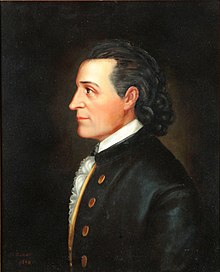| Samuel Huntington | |
|---|---|
 | |
| 3rd Governor of Ohio | |
| In office December 12, 1808 – December 8, 1810 | |
| Preceded by | Thomas Kirker |
| Succeeded by | Return J. Meigs, Jr. |
| Ohio Senate from Trumbull County | |
| In office 1803–1803 | |
| Preceded by | New District |
| Succeeded by | Benjamin Tappan |
| Ohio House of Representatives from Geauga, Ashtabula, and Cuyahoga Counties | |
| In office 1811–1812 | |
| Preceded by | Peter Hitchcock |
| Succeeded by | Samuel S. Baldwin |
| Judge of the Ohio Supreme Court | |
| In office 1803–1808 | |
| Preceded by | New Title |
| Succeeded by | Thomas Morris |
| Personal details | |
| Born | (1765-10-04)October 4, 1765 Coventry, Colony of Connecticut, British America |
| Died | June 8, 1817(1817-06-08) (aged 51) Fairport Harbor, Ohio, U.S. |
| Political party | Democratic-Republican |
Samuel Huntington (October 4, 1765 – June 8, 1817) was an American jurist who was the third governor of Ohio from 1808 to 1810.
Biography
Huntington was born in Coventry in the Colony of Connecticut. He was the nephew (and, later, the adopted son) of Samuel Huntington, the fourth President of the Continental Congress and first President of the United States in Congress Assembled under the Articles of Confederation.
Huntington studied at Dartmouth College until the end of his junior year. He then transferred to Yale College, from which he was graduated in 1785. He was admitted to the bar and began practicing law in Connecticut. In 1801, he moved to Ohio with his wife, Hannah, and their young sons, settling in the tiny village of Cleveland.
Career
After serving as a Trumbull county delegate to the State's first constitutional convention, Huntington was selected as an associate justice of the Ohio Supreme Court and succeeded Return J. Meigs, Jr. as Chief Justice a year later. He served until being elected Governor in 1808. His tenure was stormy, with much controversy over the impeachment of two judges for upholding the principle of judicial review (Huntington would have been impeached as well had he not been being elected governor), the move of the state capital from Zanesville to Chillicothe, and the Tiffin Resolution, which terminated the terms of all sitting judges. Huntington did not stand for re-election, but instead ran for the U.S. Senate, losing to Thomas Worthington.
Huntington was also an active Freemason, and served as the second Grand Master of the Grand Lodge F.&A.M. of Ohio in 1809.
References
- Occasionally known as Samuel Huntington Jr.
- Brown, Jeffrey P. (1980). "Samuel Huntington: A Connecticut Aristocrat on the Ohio Frontier". Ohio History. Ohio History Connection. pp. 419–438.
- "Huntington, Samuel, Jr". Encyclopedia of Cleveland History. Case Western Reserve University. May 31, 2019. Retrieved March 29, 2022.
- ^ "Samuel Huntington". Ohio Historical Society. Archived from the original on July 16, 2012. Retrieved July 11, 2012.
- Ryan, Daniel Joseph (1896). "First Constitutional Convention, Convened November 1, 1802". Ohio Archaeological and Historical Publications. V: 131–132.
- Support, DMG. "Grand Lodge of Ohio – 1809 – Samuel Huntington". Retrieved August 21, 2016.
External links
- [REDACTED] Media related to Samuel Huntington (Ohio politician) at Wikimedia Commons
- "Samuel Huntington". Ohio Historical Society. Archived from the original on July 16, 2012.
- "Huntington, Samuel" . Appletons' Cyclopædia of American Biography. 1900.
| Offices and distinctions | |||||||||||||||||||||||||
|---|---|---|---|---|---|---|---|---|---|---|---|---|---|---|---|---|---|---|---|---|---|---|---|---|---|
| |||||||||||||||||||||||||
- 1765 births
- 1817 deaths
- Governors of Ohio
- Ohio state senators
- Justices of the Supreme Court of Ohio
- Politicians from Cleveland
- Ohio Democratic-Republicans
- Ohio Constitutional Convention (1802)
- Democratic-Republican Party state governors of the United States
- Yale University alumni
- Masonic grand masters
- American people of English descent
- 19th-century American judges
- 18th-century American lawyers
- 19th-century American lawyers
- People from Coventry, Connecticut
- Lawyers from Cleveland
- 19th-century members of the Ohio General Assembly

